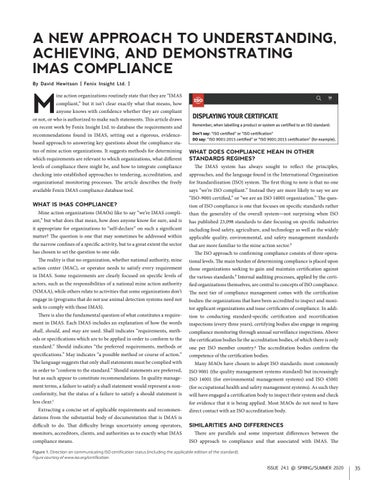A NEW APPROACH TO UNDERSTANDING, ACHIEVING, AND DEMONSTRATING IMAS COMPLIANCE By David Hewitson [ Fenix Insight Ltd. ]
M
ine action organizations routinely state that they are “IMAS compliant,” but it isn’t clear exactly what that means, how anyone knows with confidence whether they are compliant
or not, or who is authorized to make such statements. This article draws on recent work by Fenix Insight Ltd. to database the requirements and recommendations found in IMAS, setting out a rigorous, evidencebased approach to answering key questions about the compliance status of mine action organizations. It suggests methods for determining which requirements are relevant to which organizations, what different
WHAT DOES COMPLIANCE MEAN IN OTHER STANDARDS REGIMES?
levels of compliance there might be, and how to integrate compliance
The IMAS system has always sought to reflect the principles,
checking into established approaches to tendering, accreditation, and
approaches, and the language found in the International Organization
organizational monitoring processes. The article describes the freely
for Standardization (ISO) system. The first thing to note is that no one
available Fenix IMAS compliance database tool.
says “we’re ISO compliant.” Instead they are more likely to say we are
WHAT IS IMAS COMPLIANCE? Mine action organizations (MAOs) like to say “we’re IMAS compliant,” but what does that mean, how does anyone know for sure, and is it appropriate for organizations to “self-declare” on such a significant matter? The question is one that may sometimes be addressed within the narrow confines of a specific activity, but to a great extent the sector has chosen to set the question to one side. The reality is that no organization, whether national authority, mine action center (MAC), or operator needs to satisfy every requirement in IMAS. Some requirements are clearly focused on specific levels of actors, such as the responsibilities of a national mine action authority (NMAA), while others relate to activities that some organizations don’t engage in (programs that do not use animal detection systems need not seek to comply with those IMAS). There is also the fundamental question of what constitutes a requirement in IMAS. Each IMAS includes an explanation of how the words shall, should, and may are used. Shall indicates “requirements, methods or specifications which are to be applied in order to conform to the standard.” Should indicates “the preferred requirements, methods or specifications.” May indicates “a possible method or course of action.” The language suggests that only shall statements must be complied with in order to “conform to the standard.” Should statements are preferred, but as such appear to constitute recommendations. In quality management terms, a failure to satisfy a shall statement would represent a nonconformity, but the status of a failure to satisfy a should statement is less clear.1 Extracting a concise set of applicable requirements and recommendations from the substantial body of documentation that is IMAS is difficult to do. That difficulty brings uncertainty among operators, monitors, accreditors, clients, and authorities as to exactly what IMAS compliance means.
“ISO-9001 certified,” or “we are an ISO 14001 organization.” The question of ISO compliance is one that focuses on specific standards rather than the generality of the overall system—not surprising when ISO has published 23,098 standards to date focusing on specific industries including food safety, agriculture, and technology as well as the widely applicable quality, environmental, and safety management standards that are more familiar to the mine action sector.2 The ISO approach to confirming compliance consists of three operational levels. The main burden of determining compliance is placed upon those organizations seeking to gain and maintain certification against the various standards.3 Internal auditing processes, applied by the certified organizations themselves, are central to concepts of ISO compliance. The next tier of compliance management comes with the certification bodies: the organizations that have been accredited to inspect and monitor applicant organizations and issue certificates of compliance. In addition to conducting standard-specific certification and recertification inspections (every three years), certifying bodies also engage in ongoing compliance monitoring through annual surveillance inspections. Above the certification bodies lie the accreditation bodies, of which there is only one per ISO member country.4 The accreditation bodies confirm the competence of the certification bodies. Many MAOs have chosen to adopt ISO standards: most commonly ISO 9001 (the quality management systems standard) but increasingly ISO 14001 (for environmental management systems) and ISO 45001 (for occupational health and safety management systems). As such they will have engaged a certification body to inspect their system and check for evidence that it is being applied. Most MAOs do not need to have direct contact with an ISO accreditation body.
SIMILARITIES AND DIFFERENCES There are parallels and some important differences between the ISO approach to compliance and that associated with IMAS. The
Figure 1. Direction on communicating ISO certification status (including the applicable edition of the standard). Figure courtesy of www.iso.org/certification. ISSUE 24.1 @ SPRING/SUMMER 2020
35
